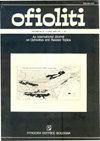海洋岩石圈逆冲的模拟:来自阿尔巴尼亚北部mirdita蛇绿岩变质底的约束
IF 1.3
4区 地球科学
Q2 GEOLOGY
引用次数: 17
摘要
东地中海的希腊-迪纳尔带以保存完好的巨大倒折蛇绿岩片为特征。发育良好且厚度很大的变质底岩通常出现在倒伏蛇绿岩层序的底部。保存最完好的希腊-迪纳尔带的变质底岩与阿尔巴尼亚蛇绿岩一起出现。在Mirdita地区(阿尔巴尼亚北部),变质底岩由厚达600米的变质沉积物和角闪岩组合而成。根据其粒度和矿物组合特征,鉴定出4种不同类型的角闪岩,分别为T1 ~ T4。所有角闪岩的原岩均为基性岩,具有OIB亲和性,是典型的洋海山板内岩浆活动的代表;没有发现MORB衍生的岩石。伴生的变质沉积岩可能来自海洋盖层。在上、下角闪岩相条件下,米地塔变质底的所有岩性均发生强烈变形。在变质底岩附近发现一个不连续的倒梯度,表明角闪岩相变质程度高。米底塔变质底的所有岩性均受绿片岩相退退的影响,但未发现进阶绿片岩相变质岩。不同类型角闪岩在变质顶极条件下表现出不同的P和T值。不同单元的温度范围为624±9°~ 796±50°C,压力始终低于0.7 GPa。不同峰变质角闪岩片与片麻岩、云母岩体之间的边界为剪切带。在角闪岩相条件下经历了两个变形阶段,绿片岩相条件下经历了第三个变形阶段。讨论了变质底岩的岩石学和构造特征,以突出逆冲过程的运动学。本文章由计算机程序翻译,如有差异,请以英文原文为准。
MODELING THE OCEANIC LITHOSPHERE OBDUCTION: CONSTRAINTS FROM THE METAMORPHIC SOLE OF MIRDITA OPHIOLITES (NORTHERN ALBANIA)
The Hellenic-Dinaric belt of the Eastern Mediterranean sea is characterized by huge and well preserved obducted slices of ophiolites. A well developed and very thick metamorphic sole generally occurs at the base of the obducted ophiolite sequences. The best preserved metamorphic sole of the Hellenic-Dinaric belt crops out in association with the Albanian ophiolites. In the Mirdita area (northern Albania) the metamorphic sole consists of an up to 600 m thick assemblage of metasediments and amphibolites. Four different types of amphibolites, referred as T1 to T4, have been identified on the basis of grain-size and mineralogical assemblages. The protoliths of all the amphibolites are basic rocks with OIB affinity, representative of within-plate magmatism typical of oceanic seamounts; no MORB derived rocks have been identified. The associated metasedimentary rocks are presumably derived from oceanic covers. All the lithologies from the Mirdita metamorphic sole are strongly deformed under lower to upper amphibolite facies conditions. A discontinuous inverted gradient is observed close to harzburgites in the metamorphic sole, that shows high-grade amphibolite facies metamorphism. There are no prograde greenschist facies metamorphic rocks, although all the lithologies from the Mirdita metamorphic sole are affected by greenschist facies retrogression. The different types of amphibolites display different P and T values at metamorphic climax conditions. The temperatures range from 624±9° to 796±50°C in the different units where the pressure is always lower than 0.7 GPa. The boundaries between the amphibolite slices with different peak metamorphism as well as the bodies of the gneisses and micaschists are sheared bands. The structural pattern common to all lithologies identified in the Mirdita metamorphic sole developed through two deformation phases under amphibolite facies conditions, followed by a third phase under greenschist facies. The petrologic and structural characteristics of the metamorphic sole are discussed in order to highlight the kinematics of the obduction process.
求助全文
通过发布文献求助,成功后即可免费获取论文全文。
去求助
来源期刊

Ofioliti
地学-地质学
CiteScore
2.40
自引率
7.70%
发文量
1
期刊介绍:
Since 1976, Ofioliti provides an international forum for original contributions and reviews in the field of the geodynamics, petrology, geochemistry, biostratigraphy, stratigraphy, tectonics and paleogeography applied to ophiolitic terrains and modern oceanic lithosphere, including their sedimentary cover. Studies of topics such as geodynamics of the mantle, the evolution of orogens including ophiolites and paleoceanography are also welcome
 求助内容:
求助内容: 应助结果提醒方式:
应助结果提醒方式:


